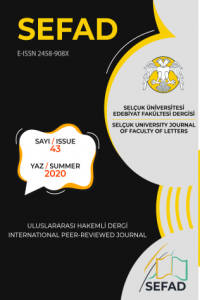Abstract
Diyalektik imge, edebi metnin özgül estetik doğasını ve anlatı karakteristiğini belirleyen ve biçimlendiren önemli bir kurgusal yapı taşıdır. Üretici olarak yazarın bilinci, imge ve gerçeklik arasında kurmaca bir dolayım sağlar. Bu kurmaca dolayım ile birlikte gerçeklik biçimleri, yazar tarafından imgeler aracılığıyla dönüşüme uğratılır. Dönüşüm süreci, kurgusal yapı içerisinde kendini gösterir. Bir edebi metnin anlatı karakteristiğini, kendine has tikelliğini belirleyen diyalektik imgeler, bu dönüşüm süreci ile ön plana çıkarılır. Diyalektik imgeler, edebi metin içerisinde ideolojiden ve yazarın niyetinden muaf yapılar değildirler. Bu anlamda edebi metinlerin, muhtelif yönelimlerini ve merkezi noktalarını saptayan kurgusal bir araç olma özelliğine sahiptirler. Adalet Ağaoğlu Türk edebiyatında toplumsal gerçekliği ve ideolojik içerikleri, estetik bir dikkatle dönüştüren ve yeniden biçimlendiren önemli yazarlardandır. Ağaoğlu’nun öykü kitapları, estetik ve ideolojinin paylaşımlı ilişkisinin metinsel bir yapıda tezahür ettiği önemli türsel oluşumlardır. Ağaoğlu’nun öykülerinde yer alan diyalektik imgeler hem estetik hem de ideolojik bir ileti biçiminde ortaya çıkarlar. Öykülerin kendine özgü kurgusal ilişkileriyle yapısal bir bütünlük oluştururlar. Çeşitli olayörgüsel çizgilerle tezatlı veya uyumlu bir görünüm elde ederler. Ağaoğlu böylelikle, metinsel bir yapı içerisinde estetik ve ideoloji arasında imgesel bir bütünlük oluşturur. Kendine özgü bir edebi duyum ve algı alanı yaratır. Bu çalışmada Ağaoğlu’nun öyküleri, estetik ve ideolojik yapıları dikkate alınarak diyalektik imge bağlamında incelenecektir.
Keywords
References
- Adorno T., Benjamin W., Bloch E., Brecht B., Lukacs G. (2016). Estetik ve Politika, A. Artun (Ed.) İstanbul: İletişim Yayınları
- Ağaoğlu A. (2015). Sessizliğin İlk Sesi, İstanbul: Everest Yayınları
- Ağaoğlu A. (2016h). Hadi Gidelim, İstanbul: Everest Yayınları
- Ağaoğlu A. (2016y). Yüksek Gerilim, İstanbul: Everest Yayınları
- Ağaoğlu A. (2017). Hayatı Savunma Biçimleri, İstanbul: Everest Yayınları
- Benjamin W. (2002). The Arcades Project, Cambridge, Mass: Belknap Press of Harvard University Press
- Benjamin W. (2014). Pasajlar, İstanbul: Yapı Kredi Yayınları
- Bourdieu P. (2015). Eril Tahakküm, İstanbul: Bağlam Yayınları
- Buck-Morss S. (1991). The Dialectics of Seeing: Walter Benjamin and the Arcades Project, Cambridge, Mass.: The MIT Press
- Cebeci O. (2009). Psikanalitik Edebiyat Kuramı, İstanbul: İthaki Yayınları
- Eagleton T. (2012). Eleştiri ve İdeoloji, İstanbul: İletişim Yayınları
- Eagleton T. (2015e). Estetiğin İdeolojisi, İstanbul: Doruk Yayımcılık
- Eagleton T. (2015ed). Edebiyat Kuramı, İstanbul: Ayrıntı Yayınları
- Eagleton T. (2015i). İdeoloji, İstanbul: Ayrıntı Yayınları
- Eagleton T. (2016). Marksizm ve Edebiyat Eleştirisi, İstanbul: İletişim Yayınları
- Marx K. (2016). 1844 EL Yazmaları, İstanbul: İletişim Yayınları
- Ricoeur P. (2016). Zaman ve Anlatı 1, İstanbul: Yapı Kredi Yayınları
- Soylu H. (2018). Adalet Ağaoğlu’nun Öykülerinde Estetik ve İdeoloji, Yüksek Lisans Tezi. Van: Van YYÜ Sosyal Bilimler Enstitüsü
- Wellek R., Warren A. (2016). Edebiyat Teorisi, İstanbul: Dergâh Yayınları
- Ziss A. (2016). Estetik, İstanbul: Hayalperest Yayınevi
- Zizek S. (2015). İdeolojinin Yüce Nesnesi, İstanbul: Metis Yayınları
Abstract
The dialectic image is an important fictional structure that determines and shapes the specific aesthetic nature and narrative characteristics of literary text. An author's consciousness as a producer provides a fictional mediation between image and reality. With this fictional mediation, the forms of reality are transformed by the author through images. The transformation process manifests itself in the fictional structure. Dialectic images that determine the narrative characteristics and unique specificity of literary text are highlighted with this transformation process. Dialectic images are not structures exempt from ideology and the author's intention in literary text. In this sense, they have the feature of being a fictional tool that determines the various orientations and central points of literary texts. Adalet Ağaoğlu is a prominent writer in modern Turkish literature that transforms and configures social reality and ideological contents in aesthetic sense. The stories of Ağaoğlu are significant literary genres which produce aesthetics and ideology’s mutual relations in a textual structure. Dialectic images in Ağaoğlu's stories emerge as both aesthetic and ideological messages. They form a structural integrity with the specific fictional relationships of the stories. In this way, Ağaoğlu forms an imaginary integrity between aesthetics and ideology within a textual structure. She creates a distinctive sense of literary perception. In this article, the stories of Ağaoğlu will be examined within the context of dialectic image considering their aesthetic and ideological structures.
References
- Adorno T., Benjamin W., Bloch E., Brecht B., Lukacs G. (2016). Estetik ve Politika, A. Artun (Ed.) İstanbul: İletişim Yayınları
- Ağaoğlu A. (2015). Sessizliğin İlk Sesi, İstanbul: Everest Yayınları
- Ağaoğlu A. (2016h). Hadi Gidelim, İstanbul: Everest Yayınları
- Ağaoğlu A. (2016y). Yüksek Gerilim, İstanbul: Everest Yayınları
- Ağaoğlu A. (2017). Hayatı Savunma Biçimleri, İstanbul: Everest Yayınları
- Benjamin W. (2002). The Arcades Project, Cambridge, Mass: Belknap Press of Harvard University Press
- Benjamin W. (2014). Pasajlar, İstanbul: Yapı Kredi Yayınları
- Bourdieu P. (2015). Eril Tahakküm, İstanbul: Bağlam Yayınları
- Buck-Morss S. (1991). The Dialectics of Seeing: Walter Benjamin and the Arcades Project, Cambridge, Mass.: The MIT Press
- Cebeci O. (2009). Psikanalitik Edebiyat Kuramı, İstanbul: İthaki Yayınları
- Eagleton T. (2012). Eleştiri ve İdeoloji, İstanbul: İletişim Yayınları
- Eagleton T. (2015e). Estetiğin İdeolojisi, İstanbul: Doruk Yayımcılık
- Eagleton T. (2015ed). Edebiyat Kuramı, İstanbul: Ayrıntı Yayınları
- Eagleton T. (2015i). İdeoloji, İstanbul: Ayrıntı Yayınları
- Eagleton T. (2016). Marksizm ve Edebiyat Eleştirisi, İstanbul: İletişim Yayınları
- Marx K. (2016). 1844 EL Yazmaları, İstanbul: İletişim Yayınları
- Ricoeur P. (2016). Zaman ve Anlatı 1, İstanbul: Yapı Kredi Yayınları
- Soylu H. (2018). Adalet Ağaoğlu’nun Öykülerinde Estetik ve İdeoloji, Yüksek Lisans Tezi. Van: Van YYÜ Sosyal Bilimler Enstitüsü
- Wellek R., Warren A. (2016). Edebiyat Teorisi, İstanbul: Dergâh Yayınları
- Ziss A. (2016). Estetik, İstanbul: Hayalperest Yayınevi
- Zizek S. (2015). İdeolojinin Yüce Nesnesi, İstanbul: Metis Yayınları
Details
| Primary Language | Turkish |
|---|---|
| Subjects | Creative Arts and Writing |
| Journal Section | Articles |
| Authors | |
| Publication Date | June 15, 2020 |
| Submission Date | October 17, 2019 |
| Published in Issue | Year 2020 Issue: 43 |
Selcuk University Journal of Faculty of Letters will start accepting articles for 2025 issues on Dergipark as of September 15, 2024.


